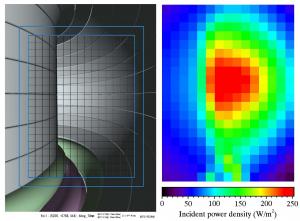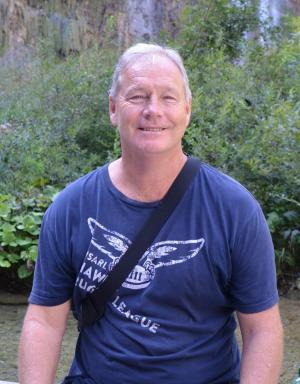Diagnostics
Scientist Fellows in action
4 May 2020
Important contributions are being made to ITER diagnostics by the 22 ITER Scientist Fellows who are currently dedicating a portion of their time to the research and development needs of the Port Plugs & Diagnostics Division.
Figures showing a CAD image of a 300-channel imaging bolometer viewing the ITER torus (left), and an image from the bolometer showing the estimated signal levels (right).
Since 2016, scientists and engineers from the ITER Members have been nominated by their home institutes to become part of the ITER Scientist Fellow Network. Fellows agree to an annual work plan in an area of interest that matches an ITER need, and work closely throughout their term with ITER specialists. Of the 60 scientists participating in the Network today, 22 are supporting ITER's Port Plugs & Diagnostics Division.
"ITER diagnostics are benefitting immensely from the involvement of the broader scientific and technical community of the ITER Members directly in development work, while the Fellows gain access to cutting-edge research topics that can enrich their work back home," says Division Head Michael Walsh.
More than 40 types of diagnostics—55 instruments in all—are planned to provide ITER operators with detailed information during plasma operation. Because of the harsh environment inside the vacuum vessel, these systems must cope with a range of phenomena not previously encountered in tokamak diagnostics, while performing with great accuracy and reliability. The following paragraphs portray a small sample of the kind of important work that is being done across the board by the ITER Scientist Fellows in diagnostics.
Artur Malaquias, from the Instituto Superior Técnico in Lisbon, Portugal, is contributing to the effort to develop advanced detectors for the radial X-ray camera diagnostic in close collaboration with the Chinese Domestic Agency (and China's ASIPP institute). Similar to a CAT scan, these detectors will provide a detailed view inside the ITER plasma, gathering information on important plasma properties such as impurity content, temperature and the presence of any unwanted high-energy electron beams. Although the operation of X-ray detectors is well documented in other fusion experiments, the ITER nuclear environment—with levels of neutron flux several orders of magnitude higher than any tokamak today—brings new challenges. With experts from all of the ITER parties working on the design of advanced detectors, one of the most effective ways to bring this knowledge to bear fruit is to structure dedicated workshops, and Artur has organized several. Experimental results as well as modelling and simulations provided valuable clues on how to blend the physics requirements and engineering solutions into a sensitive yet rugged and nuclear-proof design.
American native Byron Peterson has been working in fusion research in Japan for the last 25 years. He is currently professor of imaging diagnostics at SOKENDAI (the Graduate School for Advanced Studies), and at the National Institute for Fusion Science where he drives the bolometer diagnostics on the Large Helical Device (LHD). Bolometers measure the power lost from the plasma through electromagnetic radiation ranging from infrared to X-ray. Over 100 bolometer sensors—with a total of around 500 lines of sight—survey the ITER plasma from strategic locations inside the vacuum vessel. In collaboration with ITER staff and other Fellows, Peterson is evaluating the effects of neutrons and the signal-to-noise ratio of prospective imaging bolometers.







